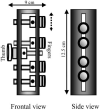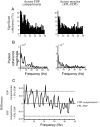Periodic modulation of motor-unit activity in extrinsic hand muscles during multidigit grasping
- PMID: 15744006
- PMCID: PMC2018608
- DOI: 10.1152/jn.01134.2004
Periodic modulation of motor-unit activity in extrinsic hand muscles during multidigit grasping
Abstract
We recently examined the extent to which motor units of digit flexor muscles receive common input during multidigit grasping. This task elicited moderate to strong motor-unit synchrony (common input strength, CIS) across muscles (flexor digitorum profundus, FDP, and flexor pollicis longus, FPL) and across FDP muscle compartments, although the strength of this common input was not uniform across digit pairs. To further characterize the neural mechanisms underlying the control of multidigit grasping, we analyzed the relationship between firing of single motor units from these hand muscles in the frequency domain by computing coherence. We report three primary findings. First, in contrast to what has been reported in intrinsic hand muscles, motor units belonging to different muscles and muscle compartments of extrinsic digit flexors exhibited significant coherence in the 0- to 5- and 5- to 10-Hz frequency ranges and much weaker coherence in the higher 10-20 Hz range (maximum 0.0025 and 0.0008, respectively, pooled across all FDP compartment pairs). Second, the strength and incidence of coherence differed considerably across digit pairs. Third, contrary to what has been reported in the literature, across-muscle coherence can be stronger and more prevalent than within-muscle coherence, as FPL-FDP2 (thumb-index digit pair) exhibited the strongest and most prevalent coherence in our data (0.010 and 43% at 3 Hz, respectively). The heterogeneous organization of common input to these muscles and muscle compartments is discussed in relation to the functional role of individual digit pairs in the coordination of multiple digit forces in grasping.
Figures







Similar articles
-
Muscle-pair specific distribution and grip-type modulation of neural common input to extrinsic digit flexors.J Neurophysiol. 2006 Sep;96(3):1258-66. doi: 10.1152/jn.00327.2006. Epub 2006 May 24. J Neurophysiol. 2006. PMID: 16723414 Free PMC article.
-
Common input to motor units of digit flexors during multi-digit grasping.J Neurophysiol. 2004 Dec;92(6):3210-20. doi: 10.1152/jn.00516.2004. Epub 2004 Jul 7. J Neurophysiol. 2004. PMID: 15240764
-
Common input to motor units of intrinsic and extrinsic hand muscles during two-digit object hold.J Neurophysiol. 2008 Mar;99(3):1119-26. doi: 10.1152/jn.01059.2007. Epub 2008 Jan 2. J Neurophysiol. 2008. PMID: 18171707 Free PMC article.
-
Task-specific motor units in the extrinsic hand muscles control single- and multidigit tasks of the human hand.J Appl Physiol (1985). 2025 May 1;138(5):1187-1200. doi: 10.1152/japplphysiol.00911.2024. Epub 2025 Apr 11. J Appl Physiol (1985). 2025. PMID: 40215131
-
Neural control of hand muscles during prehension.Adv Exp Med Biol. 2009;629:577-96. doi: 10.1007/978-0-387-77064-2_31. Adv Exp Med Biol. 2009. PMID: 19227522 Review.
Cited by
-
Coordination of intrinsic and extrinsic hand muscle activity as a function of wrist joint angle during two-digit grasping.Neurosci Lett. 2010 Apr 26;474(2):104-8. doi: 10.1016/j.neulet.2010.03.017. Epub 2010 Mar 19. Neurosci Lett. 2010. PMID: 20227463 Free PMC article.
-
Effects of hand configuration on muscle force coordination, co-contraction and concomitant intermuscular coupling during maximal isometric flexion of the fingers.Eur J Appl Physiol. 2017 Nov;117(11):2309-2320. doi: 10.1007/s00421-017-3718-6. Epub 2017 Sep 20. Eur J Appl Physiol. 2017. PMID: 28932987
-
Hand synergies: Integration of robotics and neuroscience for understanding the control of biological and artificial hands.Phys Life Rev. 2016 Jul;17:1-23. doi: 10.1016/j.plrev.2016.02.001. Epub 2016 Feb 3. Phys Life Rev. 2016. PMID: 26923030 Free PMC article. Review.
-
Factors influencing the estimates of correlation between motor unit activities in humans.PLoS One. 2012;7(9):e44894. doi: 10.1371/journal.pone.0044894. Epub 2012 Sep 25. PLoS One. 2012. PMID: 23049762 Free PMC article.
-
Muscle-pair specific distribution and grip-type modulation of neural common input to extrinsic digit flexors.J Neurophysiol. 2006 Sep;96(3):1258-66. doi: 10.1152/jn.00327.2006. Epub 2006 May 24. J Neurophysiol. 2006. PMID: 16723414 Free PMC article.
References
-
- Amjad AM, Halliday DM, Rosenberg JR, Conway BA. An extended difference of coherence test for comparing and combining several independent coherence estimates: theory and application to the study of motor units and physiological tremor. J Neurosci Methods. 1997;73:69–79. - PubMed
-
- Baker SN, Kilner JM, Pinches EM, Lemon RN. The role of synchrony and oscillations in the motor output. Exp Brain Res. 1999;128:109–117. - PubMed
-
- Baud-Bovy G, Soechting JF. Factors influencing variability in load forces in a tripod grasp. Exp Brain Res. 2002;143:57–66. - PubMed
-
- De Luca CJ, Erim Z. Common drive of motor units in regulation of muscle force. Trends Neurosci. 1994;17:299–304. - PubMed
Publication types
MeSH terms
Grants and funding
LinkOut - more resources
Full Text Sources

